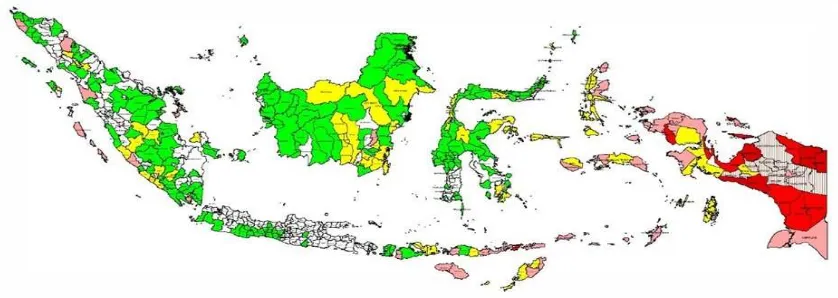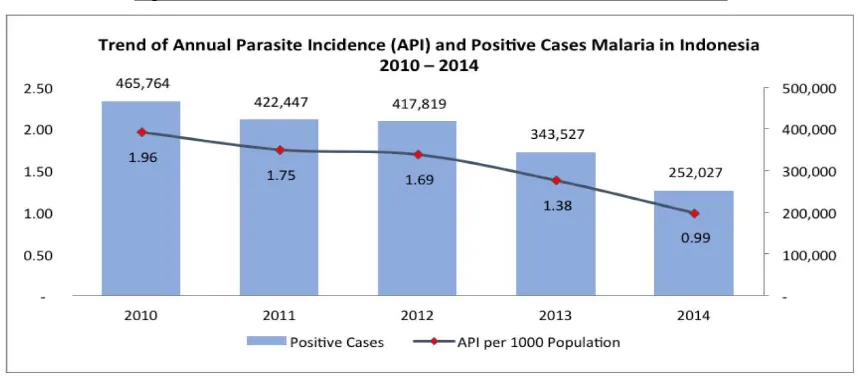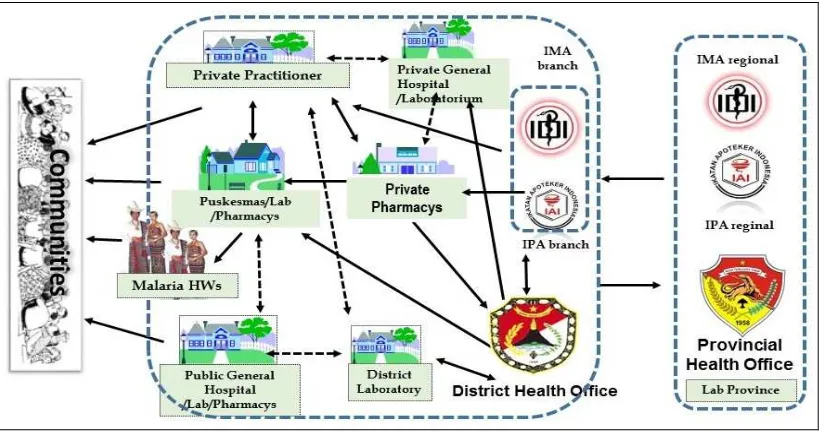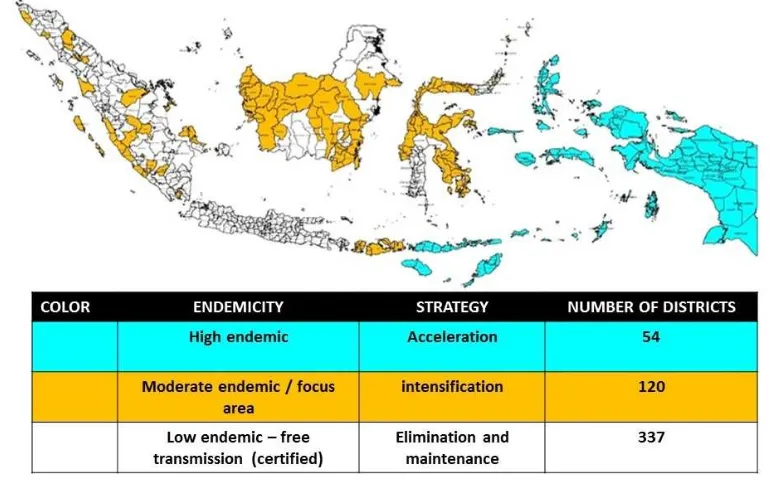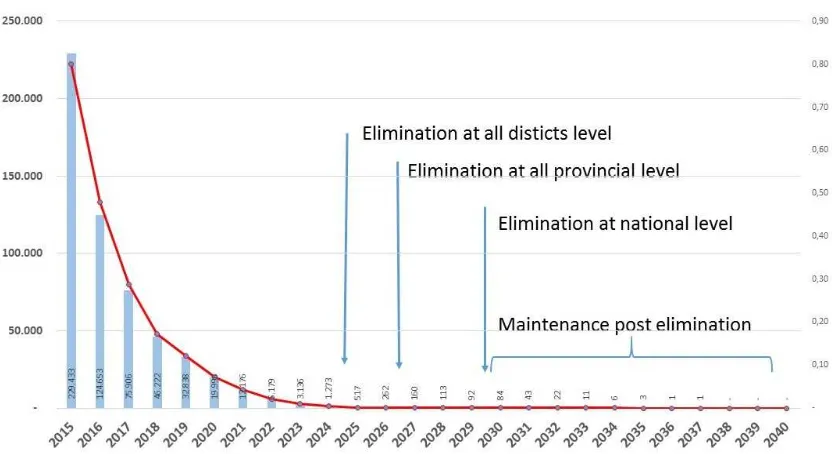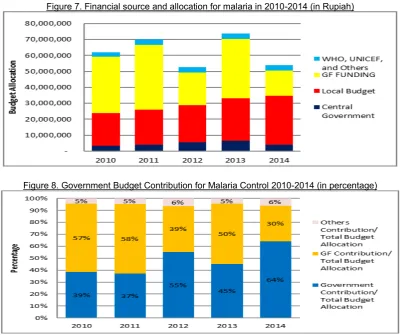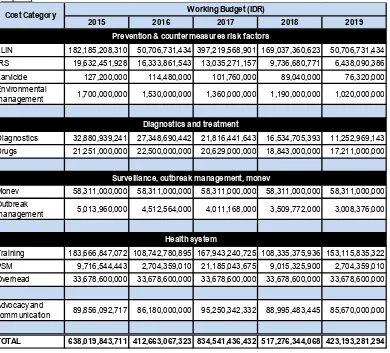INDONESIA
NATIONAL MALARIA CONTROL PROGRAM
STRATEGIC PLAN 2015-2019
BACKGROUND
Brief Story of Malaria Control in Indonesia
Malaria control and elimination in Indonesia is divided into several periods. Between 1945 and 1959, malaria control activities relied heavily upon DDT spraying. Starting in 1959, the country began a vertical malaria eradication programme known as the Komando Pembasmian Malaria (KOPEM) or Eradication of Malaria Command. In 1966 the program was halted without achieving eradication because of lack of funding from the government, Vector resistance (Anopheles (An.) aconitus) to DDT, parasite resistance (Plasmodium (P.) falciparum and P. malariae) to chloroquine and quinine.
In 1968 KOPEM was dissolved and its activities integrated into the Directorate General of Communicable Disease Prevention and Eradication. The programme was changed to Malaria Control Program and gradually integrate malaria control activities into the health care. Indonesia committed to eliminate malaria in the whole country by 2030. Malaria Elimination is introduced in different phases for different area (districts and province) as target is set differently.
Indonesia is the fourth largest country in terms of population after China, India, and the United States and is classified as a lower middle-income country. The country consists of 17,504 islands with a total land area over 1.9 million square kilometres and consist of 34 provinces, 511 districts/municipalities. The estimated population is 252 million people. Sixty percent of Indonesians live on Java and Bali, which have only only 7% of Indonesia’s land area.
Indonesia is committed to eliminate malaria in the whole country by 2030, with phased targets by region depending upon malaria endemicity.
MALARIA CONTROL IN INDONESIA
Malaria endemicity in Indonesia
Seventy-four percent of Indonesia’s population lived in environments with free-malaria (no risk), while 44% of
Indonesia’s 511 districts/municipalities are free-malaria endemic. The highest endemicity is found in Eastern Indonesia, particularly the provinces Papua, West Papua, East Nusa Tenggara (NTT), Maluku and North Maluku. In addition Bengkulu, Central Kalimantan and South Kalimantan also have relatively high malaria morbidity.
Table 1. Malaria endemicity by population and by district/municipality 2014
Endemicity Population District / City
Number Prosentase Number Prosentase
Free/No risk 186.249.171 74% 225 44.0%
Low Risk 36.204.006 14% 144 28.2%
Medium Risk 23.339.900 9% 84 16,4%
High Risk 6.331.381 3% 58 11.3%
Total 252.124.458 100% 511 100%
Malaria Control Program Achievement
Malaria cases have declined over the past decade, from 2005-2014. In 2005 Annual Parasite Incidence (API) was 4.10 per 1,000 per population, in 2012 was 1.69 per 1,000 populations (417,819 malaria cases) and in end of 2014 was 0.99 per 1000 population (252.027 malaria cases). The top-6 provinces with highest malaria-cases are Papua, West Papua, NTT, Maluku, North Maluku and Bengkulu. About 80% of malaria cases were contributed by these provinces.
Figure 2. Trend of API and Positive Malaria Cases in Indonesia 2010-2014
In 2015, 225 districts/municipalities will be certified as malaria free by an independent commission. The following table summarizes progress towards malaria elimination by district.
Table 2 .Achievement Endemicity Status By Districts/City 2015
NO ENDEMICITY MALARIA CONTROL PHASE NUMBER
1 Elimination, No indigineous case Maintenance Phase (has been certified) 225
2 Low Risk (API < 1 per 1000 populations) Elimination phase 369*)
3 Medium Risk (API 1-5 per 1000 populations) Intensification phase 84
4 High Risk (API > 5 per 1000 populations) Acceleration Phase 58**)
Notes :
*) total cumulative districts/city with API,1 per 1,000 populations included districts/city which have been certified
**) adjusted by the addition of newly created districts/muncipalities after the data completeness and expansion of districts/city
Success stories : Innovative Strategies for Malaria Control
1. Roll Back Malaria (RBM)
RBM is the coordination forum across programmes and sectors that consists of a variety of institutions, expertise and related stakeholders, assigned to assist in formulating policies and programme strategies as well as fostering the partnerships with various sectors and related programmes in order to increase the resources and the effectiveness of malaria programmes towards achieving malaria elimination in Indonesia by 2030. All the endemic provinces and several endemic districts in Indonesia have develop rules/regulations for the RBM forum in different formats based on the local situations but still have similar functions with the one on the central level
Some provinces and districts have established Malaria Centers, an institution based on initiative and commitment of the provincial or district / city level government. These centers are used as the coordination forums for malaria elimination by involving all sectors and related programs under the coordination of district or provincial health offices. By the end 2014, twenty malaria centers have been formed in the provinces of North Maluku, North Sumatera, Papua, Aceh, Bangka Belitung and recently in Teluk Bintuni, West Papua.
2. Village Malaria Post and Community Self Reliance
Partners in capacity building for Posmaldes are including faith based (religious) organizations (Perdhaki, Muhammadiyah, Nahdatul Ulama, Aisyiah, etc). By the end of 2013 more than 2440 Posmaldes have been established with 3769 cadres spread throughout remote malaria endemic villages.
Community participation also implemented in the Participatory Learning and Action (PLA) approach is activity that gives an opportunity to the community (village) to solve malaria problem in their area such as: a. Approaches in fostering community participation through the process of learning (training) and response
together with the community towards malaria elimination.
b. Involving the community to be active in recognizing malaria problems, knowing how to prevent malaria, identifying the problems and the availability of resources and developing the action plan as well as mobilizing the community.
3. Partnership with Environmental Health and Disease Control Institute and Port Health Office
Partnership with Environmental Health and Disease Control Institute, covering: referral and cross checker laboratory, malaria drug efficacy monitoring, Integrated Vector Management (IVM), malaria surveillance and outbreak control, developing the appropriate technologies for vector control.
Partnership with Port Health Office covering Implementation of surveillance including migration surveillance, early detection and treatment of malaria patients, Active malaria vector control and outbreak control, providing the relevant information for travellers who are planning to go to malaria endemic areas.
4. Partnership with Indonesian Medical Association and Association of Pharmacists Indonesia
The partnership activities including : Increasing the coverage and access to good quality of malaria services, Collaboration in improving public-private mix (PPM) of malaria services, Implementation of malaria case management standards, Implementation of pharmaceutical services and patient’s compliance and preventing malaria drug resistance, Standardized competency for medical doctors and pharmacists in malaria control programme
Figure 4. PPM implementation at local level in Maumere, District of Sikka, East Nusa Tenggara Province
In PPM networking, Health Office has the following functions and roles: a. Coordinating and facilitating health care facilities.
b. Coordinating with other health care facilities to prepare networking SOP for malaria patient services and ensuring its implementation.
c. Ensuring logistics availability such as drugs, reagents, RDT, LLINs, and etc
d. Coaching, monitoring and evaluation of PPM implementation in health care services. e. Ensuring the implementation of malaria surveillance system (recording and reporting).
5. Innovative Learning : Decreasing Malaria Endemicity at Teluk Bintuni District, Papua Barat Province.
Teluk Bintuni District was able to reduce the API the fastest compared to other districts in Indonesia. API declined from 100.07 per 1000 population (High case incidence) in 2009 to 4.44 per 1000 population (Moderate case incidence) in 2013. Teluk Bintuni District implemented innovation system called EDAT (Early Diagnosis And Treatment) consists of :
a. Improved access to diagnosis and treatment through village malaria cadre at the place that do not have health facility
b. Re-packaging anti malaria drugs c. Sustainable training
d. Social Marketing for malaria programme e. Malaria drugs control in public sector
Several excellent activities in malaria controlling programme at Teluk Bintuni District:
a. Strengthening the role of Juru Malaria Kampung (JMK) and Juru Malaria Perusahaan (JMP). b. Cooperation with companies (Coorporate Social Responsibility / CSR).
c. Strengthening the access to treatment services by utilizing JMK.
d. Training, task shifting and providing malaria kits (contain RDT and anti-malarial drugs) for JMK. e. Active case finding in remote areas by JMK and passive case finding by JMP.
f. Monthly case finding supervision by District Health Office and partners. g. Repackaging of anti-malarial drugs with certain colours based on weight scales.
h. LLINs routine distribution in collaboration with maternal child health and immunization programmes
6. Some Innovative Partnership Activities In Sikka District.
District of Sikka is situated in eastern part of Indonesia, where malaria is high endemic. Aiming to decrease morbidity and mortality caused by malaria, the district developing some innovative actions, namely:
a. Creating malaria student cadre (Laskar Jentik), Household Dasa Wisma (Srikandi Jentik) and Army Police (Patriot Jentik). The inauguration was done by the Health Minister on her working visit to the Sikka district on September 2014.
b. Strengthening malaria competency for pharmacists and physicians - Collaboration with Ministry of Education and Bank Rakyat Indonesia (BRICSR) in developing malaria local content book
c. Environmental management of mosquito-breeding lagoons with one of the NGOs (Yaspem). d. Cooperation with Sonia Radio 102.9 FM.
e. Consultation via hotline and website “Flores Bangkit”
2. Innovative lesson learn from Sabang City towards on Malaria Elimination.
Sabang city is located in Weh Island, Aceh province. It was able to decreased API malaria impressively from 87.8 / 1000 population in 2004 to below 1/1000 population in 2010. In 2013, the municipality was free of indigenous malaria transmission. Some innovative strategies toward malaria elimination in the city of Sabang:
a. Strengthening accessibility and availability of malaria services in Puskesmas and Hospital b. Active detection and mass screening activities in the community level
c. Focused Mass LLINs distribution to the community
d. Establisment of Juru Malaria Lingkungan (JML) / Environmental Malaria Cadres who are in charge on the case detection and treatment, monitoring LLINs usage by the community, and receptive environmental community monitoring by empowering JML
e. Active monitoring of imported cases and active investigation to prevent local transmission.
7. Malaria Elimination in Kepulauan Seribu-DKI Jakarta
In 2001 there were 447 cases in this district. The local government scaled-up malaria control program with a. Early diagnosis and prompt treatment
b. MBS (Mass Blood Survey)
c. Vector Control: IRS,LLIN, larvaciding
d. Strengthening the surveillance system including for import cases especially for fisherman e. Intensive community education
f. Decree of Governor and Regent about Malaria Elimination
POLICY AND STRATEGY FORMULATION
Policy and Strategy for Malaria Control
The Malaria Control Program in Indonesia operates under a legal framework related to malaria elimination efforts. The decree of the Minister of Health, No.293/MENKES/SK/IV/2009, April 28, 2009 proclaimed that Indonesia aims to eliminate malaria by 2030 to create a healthy community. This national commitment on malaria elimination is supported by the Minister of Internal Affairs through its Circular Letter No.44341/465/SJ Year 2010 on Malaria Elimination Programme implementation.
1. Operational Policy
a. Malaria Diagnostics should be done based on microscopic confirmation or Rapid Diagnostic Test (RDT) b. Treatment is by Artemisinin-based Combination Therapy (ACT) after laboratory confirmation
c. Prevention of malaria transmission through Long lasting Insecticidal Nets (LLINs), Indoor Residual Spraying (IRS), repellents and other prevention methods that have been proven effective, efficient, practical and safe
d. Malaria control programme should be implemented in line with the principles of decentralization
e. Increased commitment of central and local government is required to improve the programme management as well as to increase the effectiveness, efficiency and the quality of malaria programmes f. Strengthening community based health effort initiatives (integrating malaria Village Post into Alert
Villages)
2. Strategies
a. Special strategies, based on malaria endemicity:
Acceleration : malaria control strategy in high endemic areas (Papua, West Papua, North Maluku, Maluku and East Nusa Tenggara) The required interventions are : improved diagnosis and case management, LLINS mass campaign and IRS at village with API>40‰
Intensification ; malaria control strategy in the focus areas (mining, agriculture, foresty, transmigration, evacuation, etc) for areas outside the eastern part of Indonesia
Elimination : in low malaria endemic areas, the required interventions are active case detection, strengthening of migration surveillance, and monitoring of receptive areas.
Figure 4 : Strategy Mapping based on Malaria Endemicity
b. Functional Strategies
Improving access to good quality of malaria services
Management of anti malarial drug resistance, marginalized communities, climate change, externalities and mobile population
Strengthening of malaria surveillance and early warning system for malaria outbreak
Strengthening of the functional management,advocacy and health promotion programmes in order to support the health system
MILESTONE AND TARGETS
Indonesia aim to achieve malaria elimination in all provinces by 2027, apply for certification in 2028, so that Indonesia can be certified as malaria-free by 2030 by WHO.
Figure 5. Special Strategies based on malaria endemicity
Strategy / Phase Number of District
Number of Population
Target/ Timeline
Mid Term National Development Plan of Indonesia
Indicator : Number of districts achieved elimination status 300 198,454,177 2019
Elimination Not yet Certified 144 36,204,006 2020
Certified by MoH 225 180,249,171
Intensification 84 23,339,900 2023
Acceleration 58 6,331,381 2025
Total district/population 511 252,124,458
All district achieved elimination status / certified 2025
All province achieve elimination status / certified 2027
Apply for WHO national certification 2028
Malaria elimination in Indonesia certified by WHO 2030
National Target
a. National Mid-Term Development Plan 2015 – 2019 : Number of districts achieved elimination status (under president monitoring)
b. National Strategic of Ministry of Health 2015 – 2019 : Number of districts with API < 1 per 1000 (under MoH monitoring)
c. Presidential Commitment :
Quarter target : % of case confirmation > 95%, % of ACT treatment > 85%
Annual target : Number of districts achieved elimination status d. MDGs Target 6C up to 2015 ( the targets have been achieved)
Annual Parasite Incidence < 1 per 1000
FINANCING AND BUDGETING
Financing for Malaria Control Program
The number and proportion of financing for malaria control program from central and local government has increased year by year, especially to exit from donor dependence. Exit strategy has been implemented in many aspects including decentralization and strengthening and integrating to health system.
Figure 7 figure out the financial source from any source (central and local government, Global Fund (GF), Unicef, WHO) for malaria in 2010-2014 (in Rupiah). Figure 6 figure out proportion of funding among government, GF and other sources.
Figure 7. Financial source and allocation for malaria in 2010-2014 (in Rupiah)
Figure 8. Government Budget Contribution for Malaria Control 2010-2014 (in percentage)
Figure 10.Trend Financing Plan for Malaria Control Programme 2015-2019 (in Rupiah)
*APBN/APBD = national/local budget
Figure 7 shown the financia gap that need to be fullfilled from central and local government or another source. In 2017 the budget allocation seems to increased because of the LLIN replacement for campaign at the endemic area.
Table 11. Financing Plan for Malaria Control Program by cost category of activities 2015-2019 (in Rupiah)
2015 2016 2017 2018 2019
LLIN 182,185,208,310 50,706,731,434 397,219,568,901 169,037,360,623 50,706,731,434
IRS 19,632,451,928 16,333,861,543 13,035,271,157 9,736,680,771 6,438,090,386
Larvicide 127,200,000 114,480,000 101,760,000 89,040,000 76,320,000 Environmental
management 1,700,000,000 1,530,000,000 1,360,000,000 1,190,000,000 1,020,000,000
Diagnostics 32,880,939,241 27,348,690,442 21,816,441,643 16,534,705,393 11,252,969,143
Drugs 21,251,000,000 22,500,000,000 20,629,000,000 18,843,000,000 17,211,000,000
Monev 58,311,000,000 58,311,000,000 58,311,000,000 58,311,000,000 58,311,000,000 Outbreak
management 5,013,960,000 4,512,564,000 4,011,168,000 3,509,772,000 3,008,376,000
Training 183,666,847,072 108,742,780,895 167,943,240,725 108,335,375,936 153,115,835,322
PSM 9,716,544,443 2,704,359,010 21,185,043,675 9,015,325,900 2,704,359,010
Overhead 33,678,600,000 33,678,600,000 33,678,600,000 33,678,600,000 33,678,600,000
Advocacy and
communication 89,856,092,717 86,180,000,000 95,250,342,332 88,995,483,445 85,670,000,000
TOTAL 638,019,843,711 412,663,067,323 834,541,436,432 517,276,344,068 423,193,281,294
Cost Category Working Budget (IDR)
Prevention & countermeasures risk factors
Diagnostics and treatment
Surveillance, outbreak management, monev
